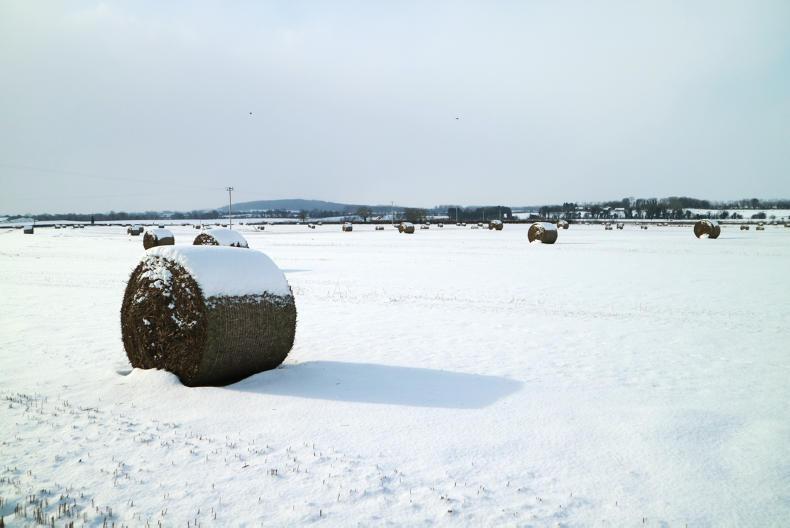Well the Beast from the East certainly didn’t disappoint as record snowfall gripped much of the nation. In many areas a layer of snow covered winter cereals, acting as a layer of insulation to frost.
Other parts of country which hadn’t seen intensive snowfalls instead had to content with sharp frosts which froze the ground solid. This may cause problems for the country's remaining potato crops.
Regardless, little field work was done over the weekend. The thaw is expected to continue this week, giving way to wetter conditions. However, temperatures will increase somewhat, with dry periods in places.
Ground conditions may be poor as heavy snowfalls melt, so field work should kept to a minimum until such time as trafficability improves.
Fertiliser
Where ground conditions are reasonable and where winter barley and winter oilseed rape crops still haven’t received nitrogen, this needs to be your top priority.
Sulphur
One of the additional challenges around an awkward spring is to get sulphur applied. This is important on all worn land that does not get regular organic fertilisers. Sulphur is important for the efficient use of N and a deficiency looks like a shortage of nitrogen.
The quantities required for cereals are roughly 15-20 kgS/ha for high yield in one early or multiple splits. Rape will need 30-40 kgS/ha on worn land that promises good yield potential.
High sulphur nitrogen products are ASN or sulphate of ammonia. Alternatively use multiple applications of low S products like CAN+S or Urea+S.
Replanting
The decision on whether to replant patches in winter crops that were damaged or are poorly established by prolonged wet weather over winter is a difficult decision. Spring-sown patches have to be marked as separate temporary parcels stating the area and crop. This will have implications for your BPS application, as well as crop husbandry.
Straw
Most of the remaining straw has been gathered in the past week and work now begins on clearing bales from the fields. In a few cases, straw has been chopped which may present problem where the straw is being incorporated into long-term tillage ground with low organic matter.
This can cause a decrease or “lock-up” of soil N as the decomposition of the carbon-rich straw causes soil microbes to take available nitrate or ammonium N from of the soil. This could potentially rob a portion of N required by spring seedlings.
Depending on the growing season, soil health and level of microbial activity, an additional 15-20kg/N/ha (12-16 units/ac) may be needed in order to compensate for this.
Read more
Weather stops field work once again
Monday management: time for first nitrogen draws closer
Well the Beast from the East certainly didn’t disappoint as record snowfall gripped much of the nation. In many areas a layer of snow covered winter cereals, acting as a layer of insulation to frost.
Other parts of country which hadn’t seen intensive snowfalls instead had to content with sharp frosts which froze the ground solid. This may cause problems for the country's remaining potato crops.
Regardless, little field work was done over the weekend. The thaw is expected to continue this week, giving way to wetter conditions. However, temperatures will increase somewhat, with dry periods in places.
Ground conditions may be poor as heavy snowfalls melt, so field work should kept to a minimum until such time as trafficability improves.
Fertiliser
Where ground conditions are reasonable and where winter barley and winter oilseed rape crops still haven’t received nitrogen, this needs to be your top priority.
Sulphur
One of the additional challenges around an awkward spring is to get sulphur applied. This is important on all worn land that does not get regular organic fertilisers. Sulphur is important for the efficient use of N and a deficiency looks like a shortage of nitrogen.
The quantities required for cereals are roughly 15-20 kgS/ha for high yield in one early or multiple splits. Rape will need 30-40 kgS/ha on worn land that promises good yield potential.
High sulphur nitrogen products are ASN or sulphate of ammonia. Alternatively use multiple applications of low S products like CAN+S or Urea+S.
Replanting
The decision on whether to replant patches in winter crops that were damaged or are poorly established by prolonged wet weather over winter is a difficult decision. Spring-sown patches have to be marked as separate temporary parcels stating the area and crop. This will have implications for your BPS application, as well as crop husbandry.
Straw
Most of the remaining straw has been gathered in the past week and work now begins on clearing bales from the fields. In a few cases, straw has been chopped which may present problem where the straw is being incorporated into long-term tillage ground with low organic matter.
This can cause a decrease or “lock-up” of soil N as the decomposition of the carbon-rich straw causes soil microbes to take available nitrate or ammonium N from of the soil. This could potentially rob a portion of N required by spring seedlings.
Depending on the growing season, soil health and level of microbial activity, an additional 15-20kg/N/ha (12-16 units/ac) may be needed in order to compensate for this.
Read more
Weather stops field work once again
Monday management: time for first nitrogen draws closer






 This is a subscriber-only article
This is a subscriber-only article










SHARING OPTIONS: